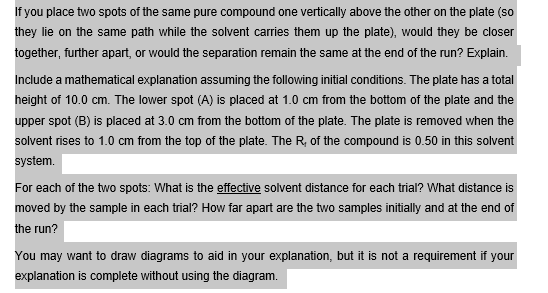If you place two spots of the same pure compound one vertically above the other on the plate (so they lie on the same path while the solvent carries them up the plate), would they be closer together, further apart, or would the separation remain the same at the end of the run? Explain. Include a mathematical explanation assuming the following initial conditions. The plate has a total height of 10.0 cm. The lower spot (A) is placed at 1.0 cm from the bottom of the plate and the upper spot (B) is placed at 3.0 cm from the bottom of the plate. The plate is removed when the solvent rises to 1.0 cm from the top of the plate. The R, of the compound is 0.50 in this solvent system. For each of the two spots: What is the effective solvent distance for each trial? What distance is moved by the sample in each trial? How far apart are the two samples initially and at the end of the run?
If you place two spots of the same pure compound one vertically above the other on the plate (so they lie on the same path while the solvent carries them up the plate), would they be closer together, further apart, or would the separation remain the same at the end of the run? Explain. Include a mathematical explanation assuming the following initial conditions. The plate has a total height of 10.0 cm. The lower spot (A) is placed at 1.0 cm from the bottom of the plate and the upper spot (B) is placed at 3.0 cm from the bottom of the plate. The plate is removed when the solvent rises to 1.0 cm from the top of the plate. The R, of the compound is 0.50 in this solvent system. For each of the two spots: What is the effective solvent distance for each trial? What distance is moved by the sample in each trial? How far apart are the two samples initially and at the end of the run?
Principles of Instrumental Analysis
7th Edition
ISBN:9781305577213
Author:Douglas A. Skoog, F. James Holler, Stanley R. Crouch
Publisher:Douglas A. Skoog, F. James Holler, Stanley R. Crouch
Chapter33: Automated Methods Of Analysis
Section: Chapter Questions
Problem 33.8QAP
Related questions
Question

Transcribed Image Text:If you place two spots of the same pure compound one vertically above the other on the plate (so
they lie on the same path while the solvent carries them up the plate), would they be closer
together, further apart, or would the separation remain the same at the end of the run? Explain.
Include a mathematical explanation assuming the following initial conditions. The plate has a total
height of 10.0 cm. The lower spot (A) is placed at 1.0 cm from the bottom of the plate and the
upper spot (B) is placed at 3.0 cm from the bottom of the plate. The plate is removed when the
solvent rises to 1.0 cm from the top of the plate. The R, of the compound is 0.50 in this solvent
system.
For each of the two spots: What is the effective solvent distance for each trial? What distance is
moved by the sample in each trial? How far apart are the two samples initially and at the end of
the run?
You may want to draw diagrams to aid in your explanation, but it is not a requirement if your
explanation is complete without using the diagram.
Expert Solution
This question has been solved!
Explore an expertly crafted, step-by-step solution for a thorough understanding of key concepts.
Step by step
Solved in 2 steps with 1 images

Knowledge Booster
Learn more about
Need a deep-dive on the concept behind this application? Look no further. Learn more about this topic, chemistry and related others by exploring similar questions and additional content below.Recommended textbooks for you

Principles of Instrumental Analysis
Chemistry
ISBN:
9781305577213
Author:
Douglas A. Skoog, F. James Holler, Stanley R. Crouch
Publisher:
Cengage Learning


Principles of Instrumental Analysis
Chemistry
ISBN:
9781305577213
Author:
Douglas A. Skoog, F. James Holler, Stanley R. Crouch
Publisher:
Cengage Learning
